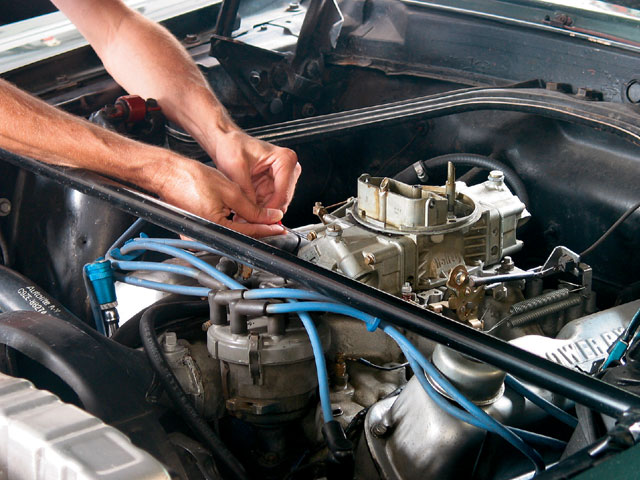The venerable carburetor is arguably the most recognizable hot rod part.
That’s because the carburetor has been the crowned jewel of some of the most revered small blocks, big blocks, HEMIs, and six-cylinders to ever grace our street rods, muscle cars, and vintage haulers. As the centerpiece of old-style fuel systems found on the majority of engines before the mid-1980s, the carburetor plays an integral role in how well—or how poorly—these engines perform.
The carburetor affects everything from fuel consumption to idle, acceleration, and high-speed driving. If you’re having issues in any of these areas (and many others), your carburetor could be the problem. Armed with our handy shop manual, we’ve compiled a list of common engine troubles and a checklist to help you track down the potential carburetor-based causes. Other conditions can also cause some of these problems, but you can use this list to find or eliminate the possible sources of your engine troubles.
What’s Causing Excessive Fuel Consumption?
Checklist: Where the carburetor is concerned, there are any number of potential culprits, including:
- Float: high float level or heavy, fuel-soaked float
- Sticky or dirty needle valves
- Worn jets or nozzles
- Rich mixture setting or high-fast idle
- Stuck accelerator pump valve
- High fuel pump pressure
- Choke: either sticking or improperly adjusted
- Vacuum leaks
Why Do I Have Lack of Acceleration or Engine Power?
Checklist: Again, there are number of possible causes, but focus on these areas first:
- The power step on the metering rod not clearing the jet
- Clogged fuel nozzle
- Stuck power valve or piston
- Low float level
- Dirty air filter
- Stuck or non-operating choke
- Intake manifold air leaks
- Improperly operating throttle valve
- Manifold heat-control valve stuck closed
Why Does My Engine Have Such Rough Idle?
Checklist
- Leaky vacuum hose
- Stuck PCV valve
- Retarded ignition timing
- Clogged idle system
- Any items listed for lack of acceleration
Why is My Engine Hard to Start Even When It’s Still Warm?
Checklist: Possible carb-related causes include:
- Defective choke or closed choke valve
- Manifold heat-control valve (where applicable) stuck
Why Does My Engine Take Forever to Warm Up?
Checklist
- Defective choke
- Manifold heat-control valve stuck open
Why Does My Vehicle Emit a Smoky Black Exhaust Gas?
Checklist: This is often a telltale sign of an overly rich condition. Not surprisingly, our checklist for carburetor-related causes contains many of the same potential causes as the ones for excessive fuel consumption:
- Float: high float level or heavy, fuel-soaked float
- Sticky or dirty needle valves
- Worn jets or nozzles
- Rich mixture setting or high-fast idle
- Stuck accelerator pump valve
- High fuel pump pressure
- Choke: either sticking or improperly adjusted
- Vacuum leaks
Why Does My Engine Stall While It’s Warming Up?
Checklist: If you’re engine wants to die out during warm-up, these areas are often the cause:
- Choke valve: improperly adjusted
- Defective choke pull-off
- Fast idle speed is too low
- Low fuel pump capacity
- Low float level
Why Does My Engine Backfire?
Checklist: This can be caused by both an overly lean or excessively rich condition, depending on the symptoms. If the backfire is in the exhaust during deceleration, the cause is a rich mixture. Lean mixtures most often show themselves in the form of “pop back” through the carburetor. Backfiring may also be caused by issues with engine valves.
Why Does My Engine Have a Miss When it Runs?
Checklist: This is often caused by a loose or leaky vacuum hose or a leaking intake manifold gasket. Start by examining those areas first and then, if necessary, move on to the carburetor itself. Sometimes a worn jet or incorrect fuel level in the float bowl will lead to improper air/fuel ratio or incorrect air/fuel volume. This can cause a pronounced miss.
Again, this is just a checklist to help you track potential issues within or around your carburetor. Some of the conditions can be fixed by simply adjusting the carburetor; others require you to remove and disassemble the carb.
Here are some quick checks you can make to ensure many aspects of your carburetor are operating properly:
Quick Checks
- Float-level adjustment: With the engine idling, remove the air cleaner and carefully look down the carburetor’s throat to the main nozzle. If it is wet or dripping with gasoline, the float level is probably too high, causing the fuel to discharge while the engine is idling.
- Idle system: If the engine idles roughly after warm up, check the idle system. Slowly open the throttle until the engine is running around 3,000 rpm. If the engine runs roughly through this range, the idle and main-metering system may be defective.
- Accelerator pump system: Check this system with the engine NOT running. With the float bowl full and air cleaner off, look down the throat of the carburetor while opening the throttle suddenly. The accelerator pump system should discharge a squirt of fuel into each primary barrel for a few seconds after the throttle valve reaches wide open. If not, the accelerator pump system is defective.
- Main metering system: With the engine warmed up and running at about 2,000 rpm, slowly cover part of the air horn with a piece of cardboard. The engine should speed up slightly as the restriction causes the main metering system to discharge more fuel.
With this information as a starting point, you can track down chronic carb issues—and become a bona fide carburetor MD!


[…] rough idle, hard starting, and more. We covered some of these issues in our Carb Detective and Carb Checklist […]
Check your FUEL FILTER, in the fuel line AND IN-CARBURETOR. Didn’t see it mention in the list. I once had a almost completely clogged fuel filter in my Quadrajet that shut my Pontiac 400.